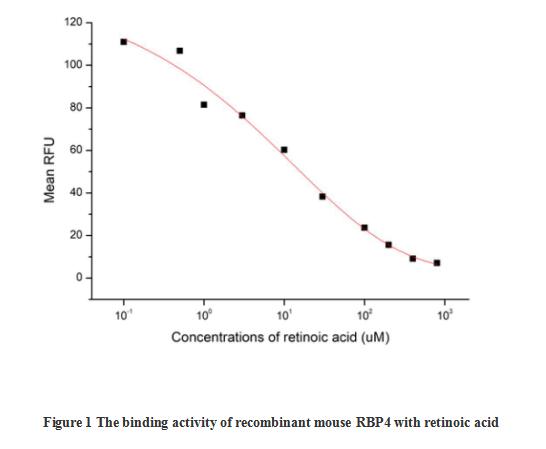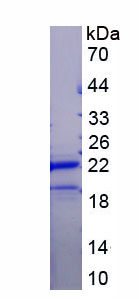Active Retinol Binding Protein 4 (RBP4)
PRBP; RBP; Plasma retinol-binding protein; Retinol Binding Protein 4, Plasma
- Product No.APA929Mu01
- Organism SpeciesMus musculus (Mouse) Same name, Different species.
- Buffer FormulationPBS, pH7.4, containing 0.01% SKL, 5% Trehalose.
- Traits Freeze-dried powder
- Purity> 90%
- Isoelectric Point6.3
- ApplicationsCell culture; Activity Assays.
- DownloadInstruction Manual
- UOM 10µg50µg 200µg 1mg 5mg
- FOB
US$ 226
US$ 565
US$ 1130
US$ 3390
US$ 8475
For more details, please contact local distributors!
ACTIVITY TEST

Retinol-binding protein 4 (RBP4) is the specific carrier for retinol (also known as vitamin A), and is responsible for the conversion of unstable and insoluble retinol in aqueous solution into stable and soluble complex in plasma through their tight interaction. As a member of the lipocalin superfamily, RBP4 containing a β-barrel structure with a well-defined cavity is secreted from the liver, and in turn delivers retinol from the liver stores to the peripheral tissues. In plasma, the RBP4-retinol complex interacts with transthyretin (TTR), and this binding is crucial for preventing RBP4 excretion through the kidney glomeruli. RBP4 expressed from an ectopic source efficiently delivers retinol to the eyes, and its deficiency affects night vision largely. Recently, RBP4 as an adipokine, is found to be expressed in adipose tissue and correlated with obesity, insulin resistance (IR) and type 2 diabetes (T2DM). The activity of recombinant mouse RBP4 was measured by its ability to bind all-trans retinoic acid. The binding of retinoic acid results in the quenching of Trp fluorescence in RBP4. RBP4 was diluted to 50 ug/ml in 50 mM Tris, 10 mM CaCl2, 150 mM NaCl, pH 7.5 (assay buffer) and the retinoic acid was diluted to 800, 400, 200, 100, 30, 10, 3, 1, 0.5 and 0.1 uM in 95% ethanol. Mixing 112.5 µL of 50 µg/mL rmRBP4 and 12.5 µL of retinoic acid serial dilutions in microtubes and a blank containing 112.5 µL of 50 µg/mL rmRBP4 and 12.5 µL of 95% ethanol, then incubate at room temperature for 30 minutes. Loading 100 ul of the reaction mixtures and blank and read at excitation and emission wavelengths of 280 nm and 340 nm (top read), respectively, in endpoint mode. The result was shown in figure 1, the 50% binding concentration (BC50) is > 4.6 µM.
USAGE
Reconstitute in 10mM PBS (pH7.4) to a concentration of 0.1-1.0 mg/mL. Do not vortex.
STORAGE
Avoid repeated freeze/thaw cycles. Store at 2-8°C for one month. Aliquot and store at -80°C for 12 months.
STABILITY
The thermal stability is described by the loss rate. The loss rate was determined by accelerated thermal degradation test, that is, incubate the protein at 37°C for 48h, and no obvious degradation and precipitation were observed. The loss rate is less than 5% within the expiration date under appropriate storage condition.
GIVEAWAYS
INCREMENT SERVICES
-
 BCA Protein Quantification Kit
BCA Protein Quantification Kit
-
 Molecular Mass Marker for Protein
Molecular Mass Marker for Protein
-
 Monoclonal Antibody Customized Service
Monoclonal Antibody Customized Service
-
 Polyclonal Antibody Customized Service
Polyclonal Antibody Customized Service
-
 Protein Activity Test Experiment Service
Protein Activity Test Experiment Service
-
 Electrophoretic Mobility Shift Assay (EMSA) Experiment Service
Electrophoretic Mobility Shift Assay (EMSA) Experiment Service
-
 Buffer
Buffer
-
 Lentivirus Packaging Experiment Service
Lentivirus Packaging Experiment Service
-
 Adenovirus Packaging Experiment Service
Adenovirus Packaging Experiment Service
-
 Real Time PCR Experimental Service
Real Time PCR Experimental Service
-
 Spike RBD Protein (S-RBD)
Spike RBD Protein (S-RBD)
-
 Protein G
Protein G
-
 Protein A
Protein A
| Magazine | Citations |
| Diabetes Technology & Therapeutics | Proteomic Identification of Human Urinary Biomarkers in Diabetes Mellitus Type 2 Liebert: 20100078 |
| Journal of Pharmaceutical and Biomedical Analysis | Effect of high dose thiamine on the levels of urinary protein biomarkers in diabetes mellitus type 2 PubMed: 21130593 |
| Evid Based Complement Alternat Med | Quercetin Protects against Cadmium-Induced Renal Uric Acid Transport System Alteration and Lipid Metabolism Disorder in Rats PubMed: PMC3368504 |
| Journal of Endocrinology | Combined galanin with insulin improves insulin sensitivity of diabetic rat muscles Pubmed:24501381 |
| J Endocrinol | Central alarin ameliorated insulin resistance of adipocytes in type 2 diabetic rats Pubmed:25240061 |
| Peptides | Effect of endogenous galanin on glucose transporter 4 expression in cardiac muscle of type 2 diabetic rats Pubmed:25445608 |
| Obesity Surgery | Long-term Effect of Ileal Transposition on Adipokine Serum Level in Zucker (Orl)-Lepr fa Fatty Rats Pubmed:25697126 |
| Clin Exp Nephrol | Differentially expressed urinary biomarkers in children with idiopathic nephrotic syndrome PubMed: 26351173 |
| Experimental and Therapeutic Medicine | Expression of retinol binding protein 4 and nuclear factor-ÎşB in diabetic rats with atherosclerosis and the intervention effect of pioglitazone Pubmed:27446311 |
| Experimental and Therapeutic Medicine | Expression of retinol binding protein 4 and nuclear factor-κB in diabetic rats with atherosclerosisand the intervention effect of pioglitazone. pubmed:27446311 |
| Journal of Chromatography A | Application of a new procedure for liquid chromatography/mass spectrometry profiling of plasma amino acid-related metabolites and untargeted shotgun proteomics to identify mechanisms and biomarkers of calcific aortic stenosis S0021967317311858 |
| BMC Cancer | Screening for immune-potentiating antigens from hepatocellular carcinoma patients after radiofrequency ablation by serum proteomic analysis Pubmed:29386009 |
| Nutrition & Diabetes | Lack of pronounced changes in the expression of fatty acid handling proteins in adipose tissue and plasma of morbidly obese humans Pubmed:29335416 |
| Molecular Medicine Reports | RBP4 regulates trophoblastic cell proliferation and invasion via the PI3K/AKT signaling pathway Pubmed:30015949 |
| Relationship between retinol and risk of diabetic retinopathy: a case-control study | |
| Scientific Reports | Retinol binding protein 4 abundance in plasma and tissues is related to body fat deposition in cattle Pubmed: 31147589 |
| Potassium supplementation blunts the effects of high salt intake on serum retinol‐binding protein 4 levels in healthy individuals | |
| Docosahexaenoic acid (DHA), a nutritional supplement, modulates steroid insensitivity in asthma | |
| Eur J Nutr | The dietary inflammatory index is associated with anti-and pro-inflammatory adipokines in Brazilian schoolchildren 33575861 |
| Eur J Pediatr | Pro-and anti-inflammatory adipokines are associated with cardiometabolic risk markers in Brazilian schoolchildren 33834274 |
| Sci Rep | Ileal transposition helps to regulate plasma hepatokine levels in obese Zucker (Crl: ZUC (ORL)-Lepr fa) rats 33833309 |
| Int Arch Occup Environ Health | Biomarkers of cadmium exposure and renal function in estuarine adult villagers 34773507 |







